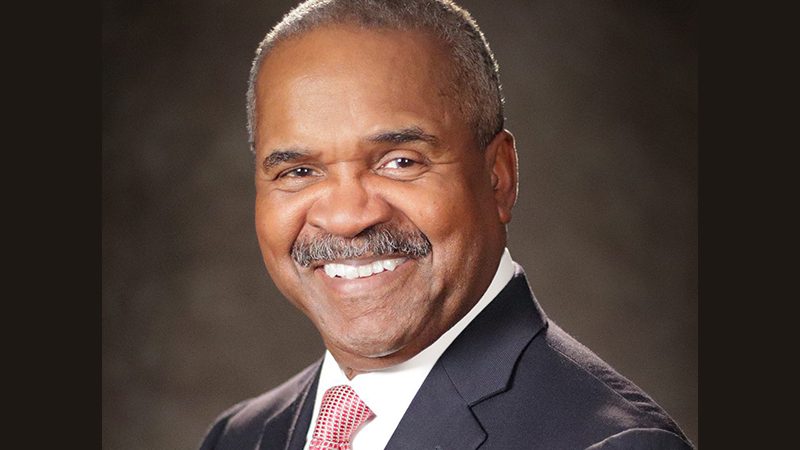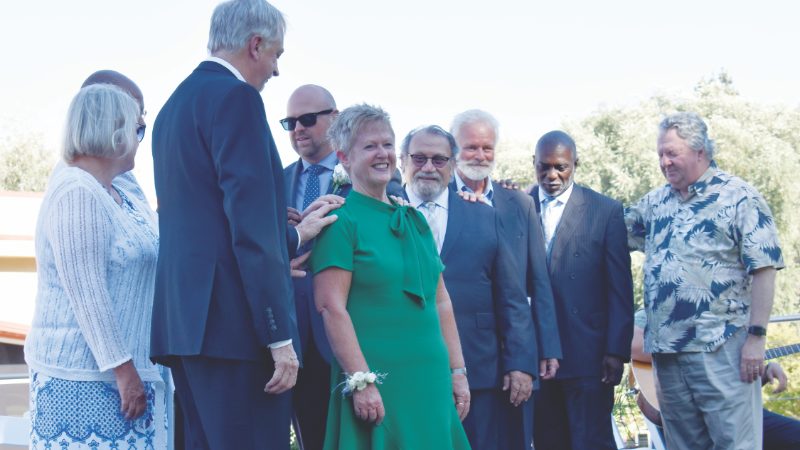By the Recorder editorial staff
The year was 1869. Evangelists John Loughborough and Daniel Bourdeau had only been in the West for a year. They had started holding tent meetings in northern California—in Petaluma, Santa Rosa, and Healdsburg.

It was in Healdsburg that they received a letter from William Hunt of Gold Hill, Nevada. He’d seen a newspaper report that, though unsympathetic, at least reported what was happening. Hunt didn’t know their names, so he addressed the letter “To the Elders at the Tent in Healdsburg, California.” He had heard they were selling books on Revelation, and he wanted one. Loughborough sent him the book, along with other literature and a letter explaining what they were doing. Hunt replied, sending money and requesting more books. Eventually, Loughborough reported that they had sent him everything the denomination published! Hunt said he believed it all and was making arrangements to keep Sabbath. He regularly sent money for the books and for tent meeting expenses.

Later Hunt came and met Loughborough, though he was leaving the country en route to New Zealand and then South Africa. In South Africa, he went to the diamond mines in Kimberley and, using the literature he had gathered, introduced the Adventist message there.
Reflecting on the positive experience that came as a result of a critical newspaper report, Loughborough observed, “By this time we knew we need not be alarmed at a little reproach against us.”1
Moving in
A more permanent Adventist presence began in 1876 when Jackson Ferguson, from Santa Rosa, California, began to hold regular Sabbath services. The following year, Loughborough reported that two families from Santa Rosa moved to St. Clair, Churchill County, Nevada. The year after that, they invited Loughborough to come and visit. He records his experience:
I arrived at Wadsworth Station Feb. 1, 1878, and was met by Jackson Ferguson who took me 35 miles across the desert to St. Clair, passing only one residence on the way. St. Clair is on the Carson River about six miles above the sink, on the edge of the Great American Desert. It is 5 miles from ‘Rag Town,’ were [sic] the immigrants stopped on Carson River for a few days to change their much-worn garments for better clothing before entering the settlements.
During February we held meetings in the Churchill County Institute, the only school building in the county. The whole community turned out and listened with great interest. In addition to those who had moved here from California, eight covenanted to keep all the commandments. When the question arose about my travel expenses and four weeks of labor, a non-member arose and said, ‘The way to raise this is to go down into our pockets and hand out the money.’ Then he laid a $20 gold piece on the desk. Others followed, and in two minutes the sum was more than made up.2
Such generosity was a common feature of the early days in the West.
Auspicious connections

One of those baptized in Reno was Charles M. Kinny, who had been born a slave in Richmond, Virginia. He had gradually made his way west. It was there in Reno that in 1878 he attended J.N. Loughborough’s evangelistic series.
During these lectures Ellen G. White visited, and on July 30 she preached to an interested audience. She records that she spoke “in the tent in which Elder Loughborough was giving a course of lectures. I spoke with freedom to about four hundred attentive hearers, on the words of John: ‘Behold, what manner of love the Father hath bestowed upon us, that we should be called the sons of God.’”3
Her sermon made an impact on Kinny. He became convinced of the Adventist message and was baptized on September 30, 1878.
Significant? Absolutely! Kinny was sponsored by the Reno church to study at Healdsburg College, and he became the first ordained Black pastor in the Adventist Church with an important ministry in various areas in the South.
Reno

Some of our brethren and sisters in Battle Creek and other favored centers should be working in Nevada.


As a result of these meetings and others in Reno, the “Seventh-day Adventist Association in the State of Nevada” was formed, later becoming the Nevada Mission. Nevada’s first Adventist church was built in Reno in 1888.

That was also the year Ellen White visited again, this time for a camp meeting. We have a record of letters she wrote while on the train. In 1905 she passed through Reno again, this time with an even more personal interest, since her granddaughter, Ella White, was teaching at the school in Reno. With her direct experience of the situation in Nevada, Ellen White made one of her very incisive observations: “Some of our brethren and sisters in Battle Creek and other favored centers should be working in Nevada.”4

Ella White Robinson, granddaughter of Ellen White, at the age of 92 wrote her memoirs, beginning when she, a child of 3, traveled to Europe with her parents and grandmother.
Churches were organized at Bishop (1903) and Fallon (1906). A report from A.J. Osborne in 1907 mentions church work at Genoa, Gardnerville, Reno, Verdi, Fallon, and St. Clair. Until 1911 the Nevada churches were under the administration of the California Conference. In 1913, the Nevada Mission was organized. In 1931, the Nevada-Utah Conference was created, with 315 members and 12 churches in Nevada.
_____________________________
1 J.N. Loughborough, Miracles in my Life (Payson, AZ: Leaves-of-Autumn Books, 1987 reprint), p. 80.
2 Loughborough, Miracles in My Life, p. 94.
3 Ellen G. White, Testimonies for the Church, vol. 4 (Mountain View, CA: Pacific Press Pub. Assn., 1885), p. 296.
4 Ellen G. White, “Notes of Travel—No. 3,” Review and Herald vol. 82, no. 7 (Feb. 16, 1905), p. 8.
Pioneros adventistas en el oeste Comienzos en Nevada
Por el personal editorial del Recorder
Corría el año 1869. Los evangelistas John Loughborough y Daniel Bourdeau solo habían estado en el oeste durante un año. Habían comenzado a celebrar reuniones en carpas en el norte de California, en Petaluma, Santa Rosa y Healdsburg.

Fue en Healdsburg donde recibieron una carta de William Hunt de Gold Hill, Nevada. Había visto un reportaje en un periódico que, aunque nada favorable, al menos informaba de lo que estaba ocurriendo. Hunt no sabía sus nombres, así que dirigió la carta «A los ancianos de la carpa en Healdsburg, California». Había oído que vendían libros sobre el Apocalipsis y quería uno. Loughborough le envió el libro, junto con otra literatura y una carta explicando lo que estaban haciendo. Hunt respondió, enviando dinero y solicitando más libros. Eventualmente, Loughborough informó que le habían enviado todo lo que la denominación publicaba. Hunt dijo que lo creía todo y que estaba haciendo arreglos para guardar el sábado. Regularmente enviaba dinero para los libros y para los gastos de las reuniones en las carpas.

Más tarde, Hunt se reunió con Loughborough, aunque dejaba el país en ruta a Nueva Zelanda y después a Sudáfrica. En Sudáfrica, fue a las minas de diamantes de Kimberley y, valiéndose de la literatura que había reunido, introdujo el mensaje adventista.
Reflexionando sobre la experiencia positiva que vino como resultado de un informe periodístico crítico, Loughborough observó: «Para entonces ya sabíamos que no teníamos que alarmarnos por un pequeño reproche contra nosotros».1
Avance
Una presencia adventista más permanente comenzó en 1876 cuando Jackson Ferguson, de Santa Rosa, California, comenzó a celebrar servicios regulares del sábado. Al año siguiente, Loughborough informó que dos familias de Santa Rosa se mudaron a St. Clair, condado de Churchill, Nevada. Al año siguiente, invitaron a Loughborough a visitarlo. Loughborough su experiencia:
Llegué a la estación de Wadsworth el 1 de febrero de 1878 y me recibió Jackson Ferguson, quien me llevó 35 millas a través del desierto hasta St. Clair, pasando solo por una residencia en el camino. St. Clair está en el río Carson, a unas seis millas por encima del sumidero, en el borde del Gran Desierto Americano. Está a 5 millas de «Rag Town», donde los inmigrantes se detuvieron en el río Carson durante unos días para cambiar sus prendas muy gastadas por mejores antes de entrar en el poblado.
Durante el mes de febrero tuvimos reuniones en el Churchill County Institute, el único edificio escolar en el condado. Toda la comunidad acudió y escuchó con gran interés. Además de los que se habían mudado aquí desde California, ocho se comprometieron a guardar todos los mandamientos. Cuando surgió la pregunta acerca de mis gastos de viaje y cuatro semanas de trabajo, una persona que no era miembro se levantó y dijo: «La manera de recaudar esto es meternos en los bolsillos y entregar el dinero». Luego colocó una moneda de oro de 20 dólares sobre el escritorio. Le siguieron otros, y en dos minutos la suma estaba más que compensada.2
Tal generosidad fue una característica común de los primeros días en el oeste.
Conexiones auspiciosas

Uno de los que se bautizó en Reno fue Charles M. Kinny, que había nacido esclavo en Richmond (Virginia). Poco a poco se había ido abriendo camino hacia el oeste. Fue allí, en Reno, donde en 1878 asistió a la serie evangelística de J.N. Loughborough.
Durante esas conferencias, Ellen G. White visitó, y el 30 de julio predicó a un auditorio interesado. Ella registra que habló «en la carpa en la que el pastor Loughborough estaba dando un curso de conferencias. Hablé con libertad a unos cuatrocientos oyentes atentos, sobre las palabras de Juan: “He aquí qué amor nos ha concedido el Padre, para que seamos llamados hijos de Dios”».3
Su sermón tuvo un impacto en Kinny. Se convenció del mensaje adventista y fue bautizado el 30 de septiembre de 1878.
¿Significativo? ¡Absolutamente! Kinny fue patrocinado por la iglesia de Reno para estudiar en Healdsburg College, y se convirtió en el primer pastor negro ordenado en la Iglesia Adventista con un ministerio importante en varias áreas del sur.
Reno

«Algunos de nuestros hermanos y hermanas en Battle Creek y otros centros favorecidos deberían estar trabajando en Nevada»


Como resultado de esas reuniones y otras en Reno, se formó la «Seventh-day Adventist Association en el estado de Nevada», que más tarde se convirtió en la Nevada Mission. La primera iglesia adventista de Nevada fue construida en Reno en 1888.

Ese fue también el año que Ellen White visitó de nuevo, esa vez para un campestre. Tenemos un registro de las cartas que escribió mientras estaba en el tren. En 1905 volvió a pasar por Reno, esta vez con un interés aún más personal, ya que su nieta, Ella White, enseñaba en la escuela de Reno. Con su experiencia directa de la situación en Nevada, Ellen White hizo una de sus observaciones muy incisivas: «Algunos de nuestros hermanos y hermanas en Battle Creek y otros centros favorecidos deberían estar trabajando en Nevada».4

Ella White Robinson, nieta de Ellen White, a la edad de 92 años escribió sus memorias, comenzando cuando ella, una niña de 3 años, viajó a Europa con sus padres y su abuela.
Se organizaron iglesias en Bishop (1903) y Fallon (1906). Un informe de A.J. Osborne en 1907 menciona el trabajo de la iglesia en Genoa, Gardnerville, Reno, Verdi, Fallon y St. Clair. Hasta 1911, las iglesias de Nevada estaban bajo la administración de la California Conference. En 1913, se organizó la Nevada Mission. En 1931, se creó la Nevada-Utah Conference, con 315 miembros y 12 iglesias en Nevada.
_____________________________
1 J.N. Loughborough, Miracles in my Life (Payson, AZ: Leaves-of-Autumn Books, 1987 reprint), p. 80.
2 Loughborough, Miracles in My Life, p. 94.
3 Ellen G. White, Testimonies for the Church, vol. 4 (Mountain View, CA: Pacific Press Pub. Assn., 1885), p. 296.
4 Ellen G. White, «Notes of Travel—No. 3,» Review and Herald vol. 82, no. 7 (Feb. 16, 1905), p. 8.








